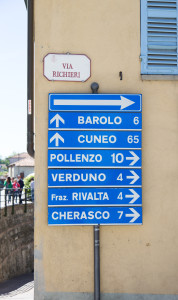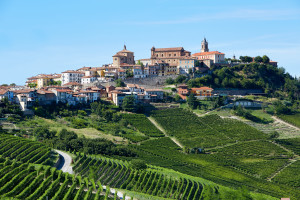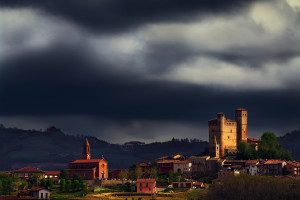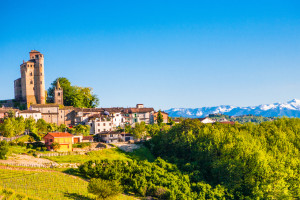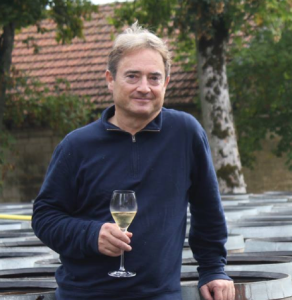Today we have a preview of a session to be presented during SWE’s 42nd Annual Conference, to be held on August 15–17, 2018 in the Finger Lakes Region of New York State. Our guest author is Alan Tardi, who tells us about his upcoming session entitled Icons of Barolo.
I am pleased to report that the line-up of wines for my session “Icons of Barolo” is essentially set and it is indeed a stellar one, representing exceptional wineries and definitive vineyard sites, as well as a range of wine making styles and a variety of different vintages. Here’s a preview:
Marchesi di Barolo is the historic winery in the heart of Barolo that used to belong to Marchese Carlo Tancredi Falletti di Barolo and his wife Giulia Colbert-Falletti. This is one of the actual places where the wine that came to be known as Barolo was born and Cannubi is one of the oldest and most revered sites in the entire winegrowing area. [Barolo “Cannubi” 2011]
The castle in the nearby town of Verduno is another site that could rightfully be called a birthplace of Barolo: It once belonged to Carlo Alberto, King of the Savoy dynasty and father of Vittorio Emmanuel II who would later become the first king of the Unified Italy (and create his own winery in Serralunga called Fontanafredda). General Staglieno, who oversaw winemaking for the king’s estates and is credited with refining enological practices in order to make a fully fermented dry Barolo, actually lived at the Verduno castle while overseeing the royal cellars in nearby Pollenzo. The castle was eventually acquired by a successful Verduno winemaker named Gian Battista Burlotto who was one of the founding fathers of the Barolo appellation. Verduno represents a distinctive geologic formation of the Messinian age in the Barolo area and Monvigliero is the town’s most renowned vineyard. [Barolo “Monvigliero” 2014]
The Elvio Cogno winery in Novello, right next to Barolo, occupies a subzone in the eastern part of the town known as Ravera. Here, besides waging a campaign to get an old local grape variety called Nascetta recognized under the Langhe appellation (and thus helping to save it from extinction), they have also focused on the cultivation of the three main subvarities of Nebbiolo — Lampia, Michet and Rose — in different sections of their estate. Michet, it has been determined, is actually a virus-affected version of Lampia while Rose, long esteemed for its incredible delicacy and pronounced aroma, is actually a genetically distinct cultivar. Elvio Cogno is one of very few producers to make a 100% Rose Barolo in exceptional vintages from a parcel of old-vines. [Barolo “Vigna Elena” 2006]
Over in La Morra, Roberto Voerzio could be viewed as both iconic and iconoclastic. While many refer to him as a ‘modernist’ he is actually a free-thinker who has developed a very unique approach to achieve a traditional objective of expressing the uniqueness of each terroir in his wines. He plants very densely and prunes very shortly, realizing an incredibly low yield of grapes from his vines. One might logically expect this to produce over-concentrated imbalanced wines, and in most peoples’ hands that might well be the case. But while Voerzio’s wines are indeed intense, they are also perfectly balanced, multi-layered, long on the palate and full of finesse. They are also reflective of the site they come from and have the capacity to evolve over a long period of time. [Barolo “Fossati Case Nere 2007”]
Moving eastwards, Castiglione Falletto is located squarely in the middle of the Barolo zone and thus a meeting ground of the area’s two principal geologic ages, the Serravalian and the Tortonian. The Villero vineyard, one of Castiglione’s oldest and one of the most prestigious of the entire area, is decidedly more Serravalian, with compact clay, marl and limestone along with a moderate slope and west-southwestern exposition. This is a relatively large vineyard with some 15 proprietors, one of whom is the Oddero winery in the Santa Maria hamlet of La Morra. Oddero is one of the oldest producers in Barolo, tracing its winemaking origins back to the 18th century, and over time has acquired holdings in many of the region’s most acclaimed vineyards. Their winemaking approach, while refined over the years, remains staunchly traditional and very consistent, thus showcasing the unique features of each Barolo site. [Barolo “Villero” 2008]
Right across the road from Villero is another vineyard that, notwithstanding its close proximity, is completely different. Rocche, another ancient and esteemed vineyard of the Barolo region, is more Tortonian in configuration. The vineyard is very narrow, quite long and extremely steep because it sits atop an east-facing cliff, and the vines end at a 40- to 50-foot drop straight down to the Perno River below. The topsoil is extremely shallow with a high amount of sand and blue marl, and underneath is pure rock, resulting in wines that, though typically lighter in color and lighter-bodied, have always been valued for their eloquence and perfume. Rocche was also one of the very first wines to be bottled as a single-vineyard in the early 1960s. The Brovia winery was founded in Castiglione Falletto in 1863 and is located near Rocche, at the foot of Villero vineyard where they also have a plot. [Barolo “Rocche di Castiglione” 2010]
The village of Serralunga, located on the eastern edge of the zone is decidedly Serravalian territory and Vigna Rionda is the emblematic vineyard of Serralunga as well as one of the most prestigious of the entire zone. Here, the steep slope and full southwestern exposure combined with the older soil composed of densely compact clay, lime and marl over limestone, create Barolos of enormous intensity and depth with a firm tannic backbone and taut musculature. The aromas may be a bit withdrawn at first but reveal themselves gradually over time and the wines have amazing longevity. Massolino winery, founded in Serralunga in 1896, has a long and close connection with the Vigna Rionda vineyard, so close in fact that they named their winery after it! [Barolo “Vignarionda” Riserva 2009]
Overall, if you connect-the-dots between these remarkable wines, visionary winemakers and emblematic vineyard sites, a vivid constellation of a magnificent winegrowing area emerges that you can not only see and admire but also taste.
About the speaker: Alan Tardi, former NYC chef and restaurateur, has long worked as a freelance journalist authoring articles about wine and food for numerous publications including The New York Times, Wine & Spirits Magazine, The Wine Spectator, Decanter, Sommelier Journal, and Food Arts. In 2003, Alan moved to the village of Castiglione Falletto in the heart of the Barolo region in Piemonte, Italy, where he spent several years working in the surrounding vineyards and wineries through all phases of the growing and production process, an experience which completely changed his perspective on wine. In 2009 Alan began frequenting the Conegliano Valdobbiadene Prosecco winegrowing area and, after successive visits during which he developed a rapport with many local farmers and producers, as well as principals of the governing Consortium, was named first ever US Ambassador of Conegliano Valdobbiadene in January 2015. His first book, ‘Romancing the Vine: Life, Love and Transformation in the Vineyards of Barolo’ (St Martins Press, 2006) won a James Beard Award for Best Wine and Spirits Book of 2006. And a new book, “Champagne, Uncorked: The House of Krug and the Timeless Allure of the World’s Most Celebrated Drink” (Hachette/PublicAffairs 2016) recently won a Gourmand Best in the World Award in the French Wine category.
Alan’s session, Icons of Barolo, will be offered on Friday, August 18, 2018 at 3:00 pm as part of the 42nd Annual Conference of the Society of Wine Educators to be held in the Finger Lakes Region of New York State.
